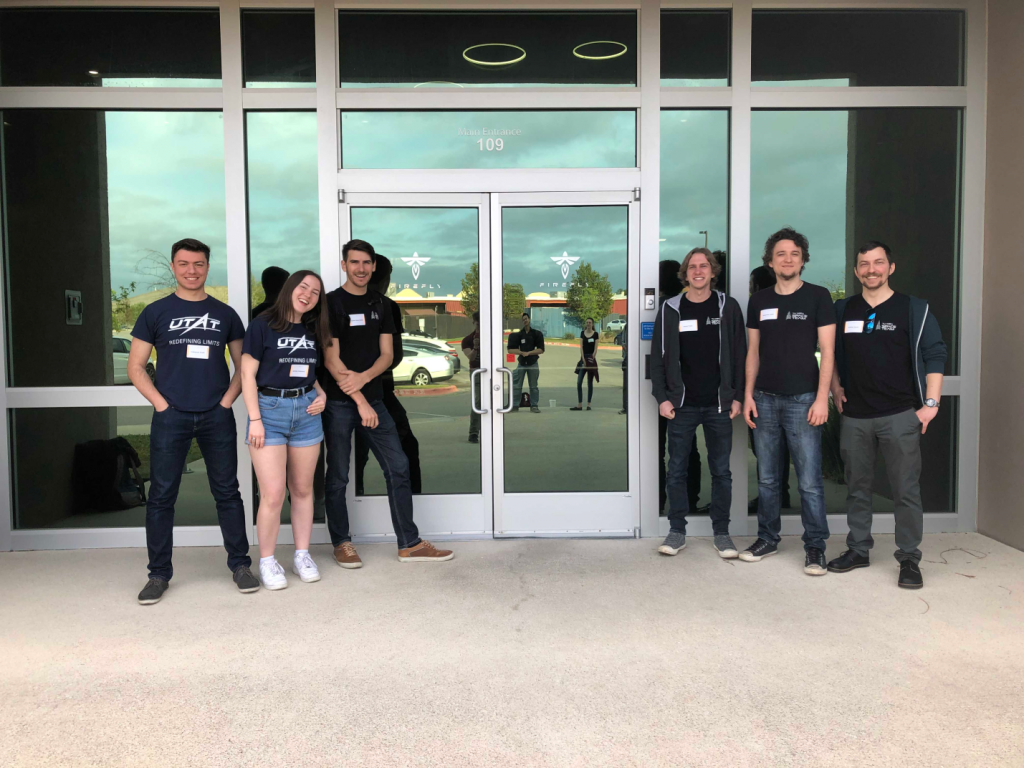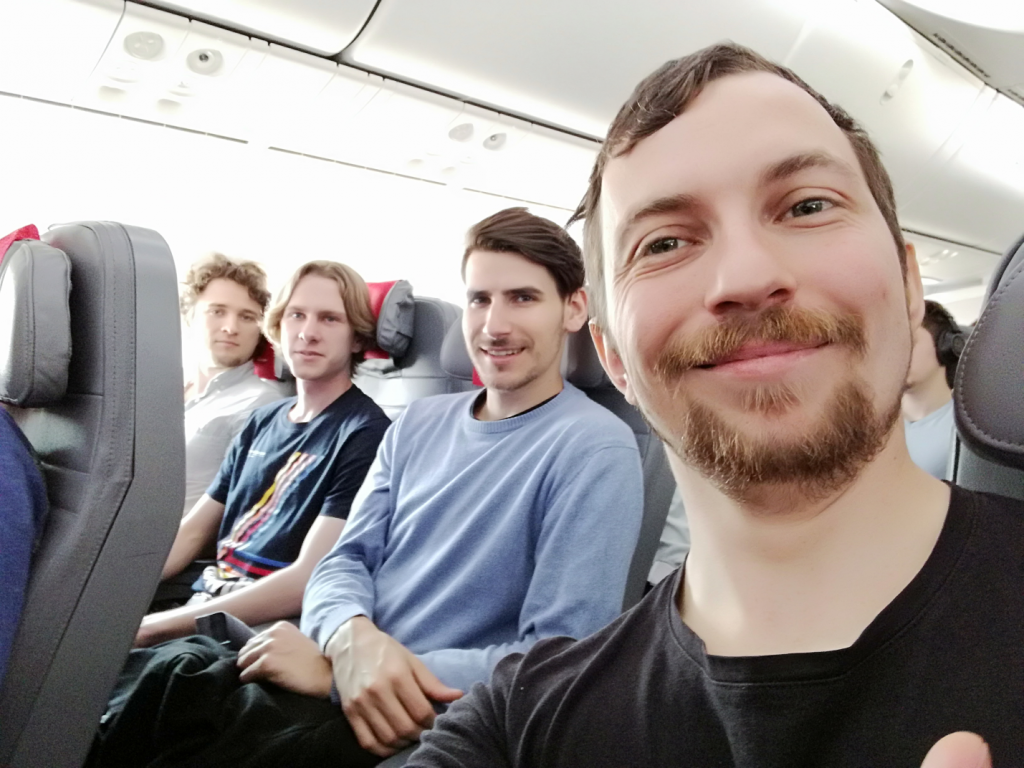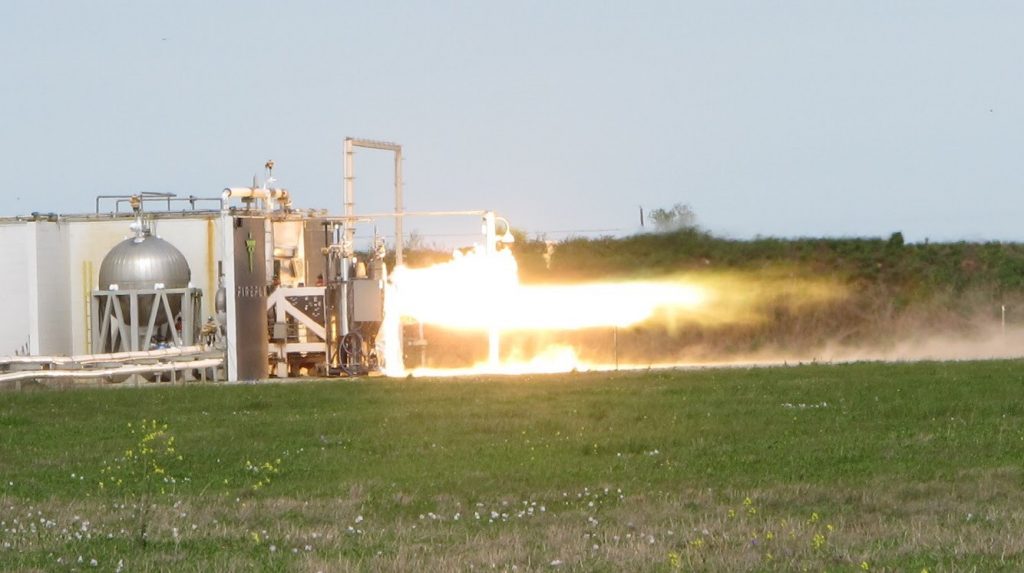Together with our Canadian partners, four members of TU Wien Space Team traveled to Austin, Texas, in order to attend the Base11 hot fire demonstration held at Firefly Aerospace. Besides the hot fire demonstration, which gave a detailed insight on how the professionals attend engine testing and the accompanying safety workshop, the 5 days stay was used to visit Firefly’s production plant and test facilities, as well as further project planning and networking with other Base11 teams, mentors and firefly engineers. The proximity to Houston was put to good use by visiting the Johnson Space Center and inspecting the last remaining complete Saturn V moon rocket, including the mighty F1 Engines.
Day 1: Journey & Arrival
After taking off from Vienna on Thursday and a night at Gatwick Airport, our group of four, consisting of CEO, Chief Engineer, Avionics Lead and Propellant Management Lead, was on its way to Texas. After a 10 hour flight we finally landed at Austin Bergstrom Airport and transferred to our quarters, a small apartment at Austin suburbs. Our Canadian friends, who had arrived one day prior, were already waiting for us. After some conversation we went to the city in order to meet up with Adam Trumpour, one of our mentors and member of the Base11 safety council as well as two other Canadian rocketry teams. The rest of the evening was put to good use eating original Texas BBQ while discussing our various rocket designs for the upcoming challenge.
Day 2: Firefly Aerospace
The next day started early. After picking up our car, we drove to Firefly Aerospace headquarters, located at Cedar Park, just outside of Austin. After arriving and a short introduction Thomas Markusic, CEO of Firefly Aerospace, held an inspiring lecture on the new space movement, the story of firefly aerospace and the challenges and difficulties associated with founding an aerospace startup and commercial rocket development. Furthermore, he introduced the teams to Firefly’s hardware based development process, following the doctrine of “Build & Design Fast, Test, Repeat”.
Following to this inspiring talk, two more lectures on hardware-based development and testing as well as a safety Q&A session with Adam Trumpour and the Firefly engine test coordinator were conducted before we boarded the buses that were going to take us to the Firefly manufacturing plant and test site. Located in rural Texas, surrounded by vast planes and Texas Longhorns, Firefly Aerospace houses three large scale manufacturing halls as well as three test stands for component- engine and integration testing. While the small engine test stand was inaccessible due to hot fire preparation, we had the unique chance to look at the big full integration test stand. Standing almost 30 meters tall, this test stand has the capability for full duration testing of the fully integrated second and first stage of Firefly’s Alpha Launch vehicle. We also received a brief tour on the component test stand, mainly used for hydrostatic and cryo loaded burst testing of Firefly’s in House manufactured composite propellant tanks.
After visiting the testing facilities, we inspectedthe engine production and assembly plant as well as the composite manufacturing hall, getting a firsthand impression on Firefly’s amazing composite technology and engine assembly. Firefly engineers willingly answered all our questions and gave us a detailed and amazing insight into the company’s technologies and manufacturing procedures.
Then, finally, engineers reported that everything was ready for the scheduled hot fire test of a brand new “Lightning” engine. This gas generator cycle LOX/Kerosene engine produces a thrust of 70 KN and is designed to power the second stage of the Alpha launch vehicle. From a safe distance but with excellent view at the test stand, we witnessed our first large scale hot fire test ever. Firefly engineers impressively and effectively demonstrated the capabilities of their testing facility as well as of their rocket engine. After the completion of the hot firet test, we drove back to Cedar Park attending the final workshop of the day, a introduction and demonstration of Dassault Systems 3DExperience platform at Firefly Headquarters. After finishing the schedule, we went or dinner with a few other Base11 teams for networking and discussion of our designs.
Day 3: Visit of Johnson Space Center
Due to the proximity of Houston, we decided to do a trip to Johnson Space Center. After taking a tour through the astronaut training facility, we went to Johnson Space Center Rocket Park in order to take a close look on the last remaining fully flight certified Saturn V moon rocket. Even though having seen a lot of footage of this rocket, seeing this behemoth rocket live is on another level. While the shear size was incredibly impressive, most astonishing was the fact, that most components of the rocket, even the massive F1 Rocket engine seems to be designed incredibly sparse if not fragile. Regarding the size of the rocket, everything ranging from the gimbal’s hydraulics actuator up to the thickness of the engine bell wall was quite of ordinary size, not comparable to the shear size of the rocket itself, therefore highlighting the ingenuity that went into that incredible rocket. Inspired by the extraordinary design and spirit of this iconic rocket, we returned to Austin.
Day 4: Project Management & Team Structuring
We spent our fourth day at our apartment in Austin in order to work through the topics we considered most urgent to discuss from face to face. This included creating an overview of our sponsors and supporters, listing our capabilities regarding material acquisition and manufacturing and discussing ways of more efficient ways of sponsoring and resource acquisition. Other topics to focus on were our strategy for upcoming testing and development events and our hardware-based design approach: Focusing on using mostly our in house manufacturing capabilities for manufacturing testing objects. Finally, we discussed general member management with the focus on how to integrate new members efficiently in our team and data management & restructuring. After another Texas BBQ right at Austin Downtown, we used the rest of the evening in order to train our aerospace engineering skills by playing Kerbal Space Program.
Day 5: Meeting with Firefly Aerospace and Journey Back Home:
Our final day at Austin began with saying goodbye to our friends from Toronto, since their flight was leaving right in the morning. After returning to our apartment, we took a cab back to Cedar Park, where we met with Roderic Vanderscoff, lead propulsion engineer for Firefly’s Reaver first stage engine. We had some coffee and some very inspiring talk about our Dragon Scale material, engine development and rocket technology in general. Being inspired by the great advice from Roderic, we finally attended our journey back home. After almost 24 hours of travel time, we finally reached Vienna, tired, but full of new ideas, knowledge, visions and inspiration for our Rocketry Development Program.
Finally, we want to thank our various supporters that this exciting and beneficial trip possible:
- The Austrian FFG and BMVIT, who helped us fund this journey by covering transfer costs from Vienna to Austin and back.
- Adam Trumpour and the Base11 Team, who did a great job by organizing the hot fire demonstration & workshop and who were of great help realizing the trip.
- Roderic Vanderscoff for his time, inspiration and great advice.
- A big shout-out to Firefly Aerospace, which did a great job at hosting this event, and went through a lot of effort in order to provide young engineers with a detailed look into the way of how professionals build rockets!
Stay tuned for more Information and updates on our projects. Stay safe and see you in space!


